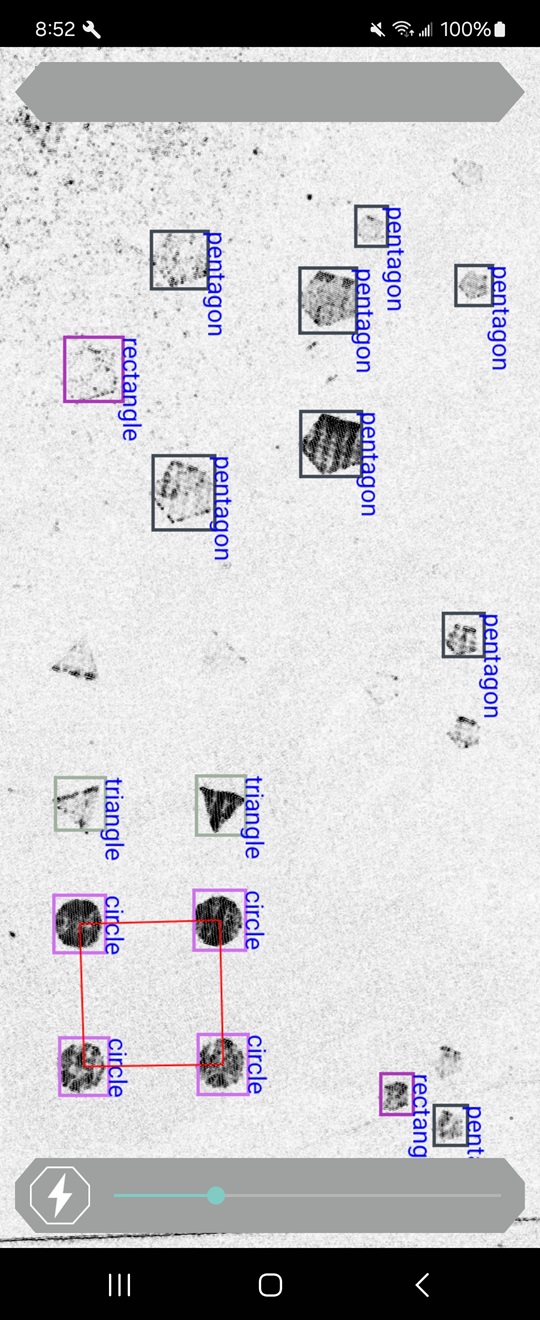iOS App - Swift / Storyboard / CoreML
- The iOS app was developed using the Swift language, and UI design was implemented using Storyboard. GPUImage/OpenCV were utilized to reveal hidden shapes, while CoreML/Vision Framework were used for shape recognition.
Image Processing / GPUImage2
-
The original image contains hidden shapes that are imperceptible to the human eye, and the GPUImage filter reveals these hidden shapes.
-
Original Image
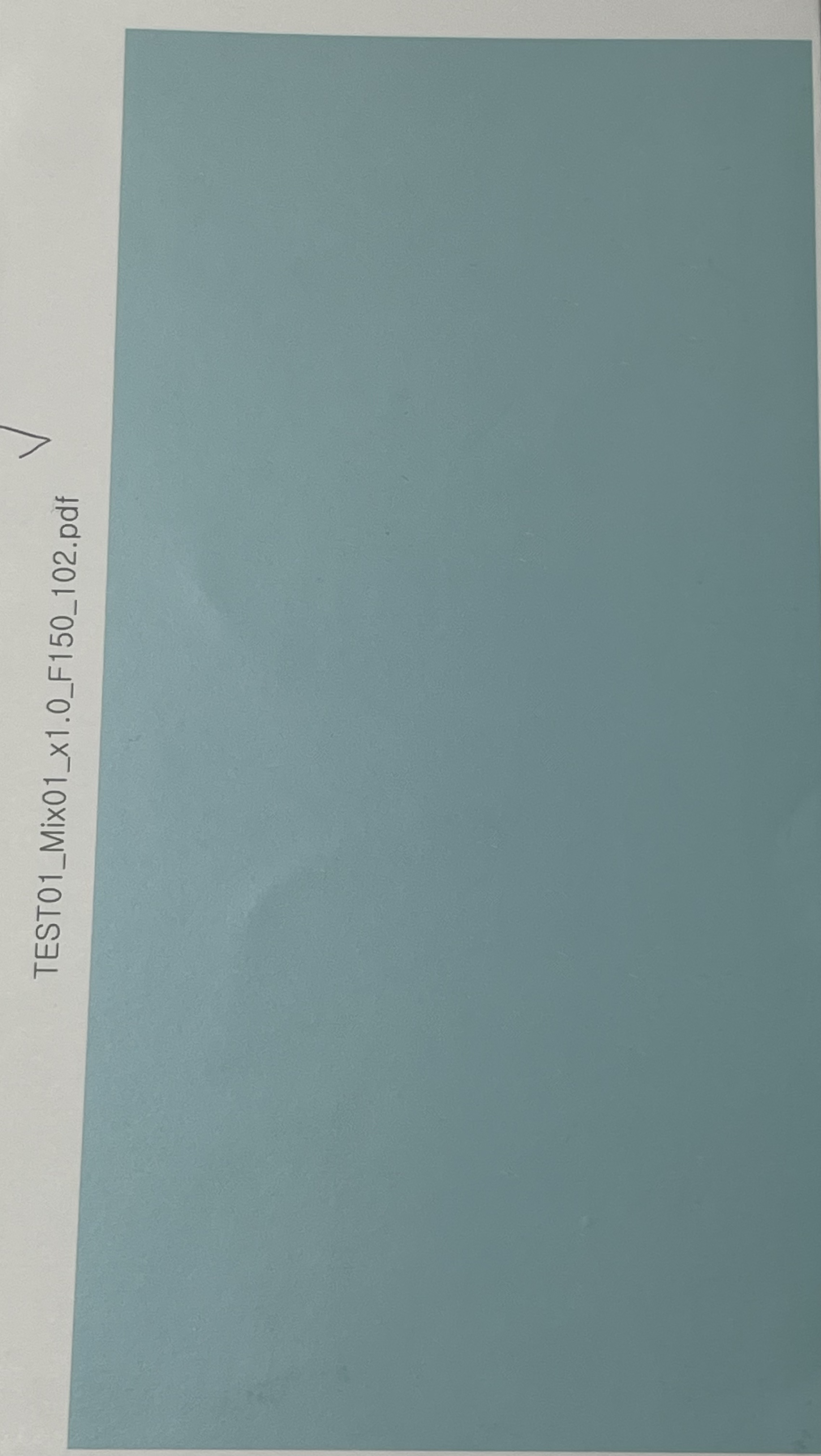
- Processed by GPUImage/OpenCV
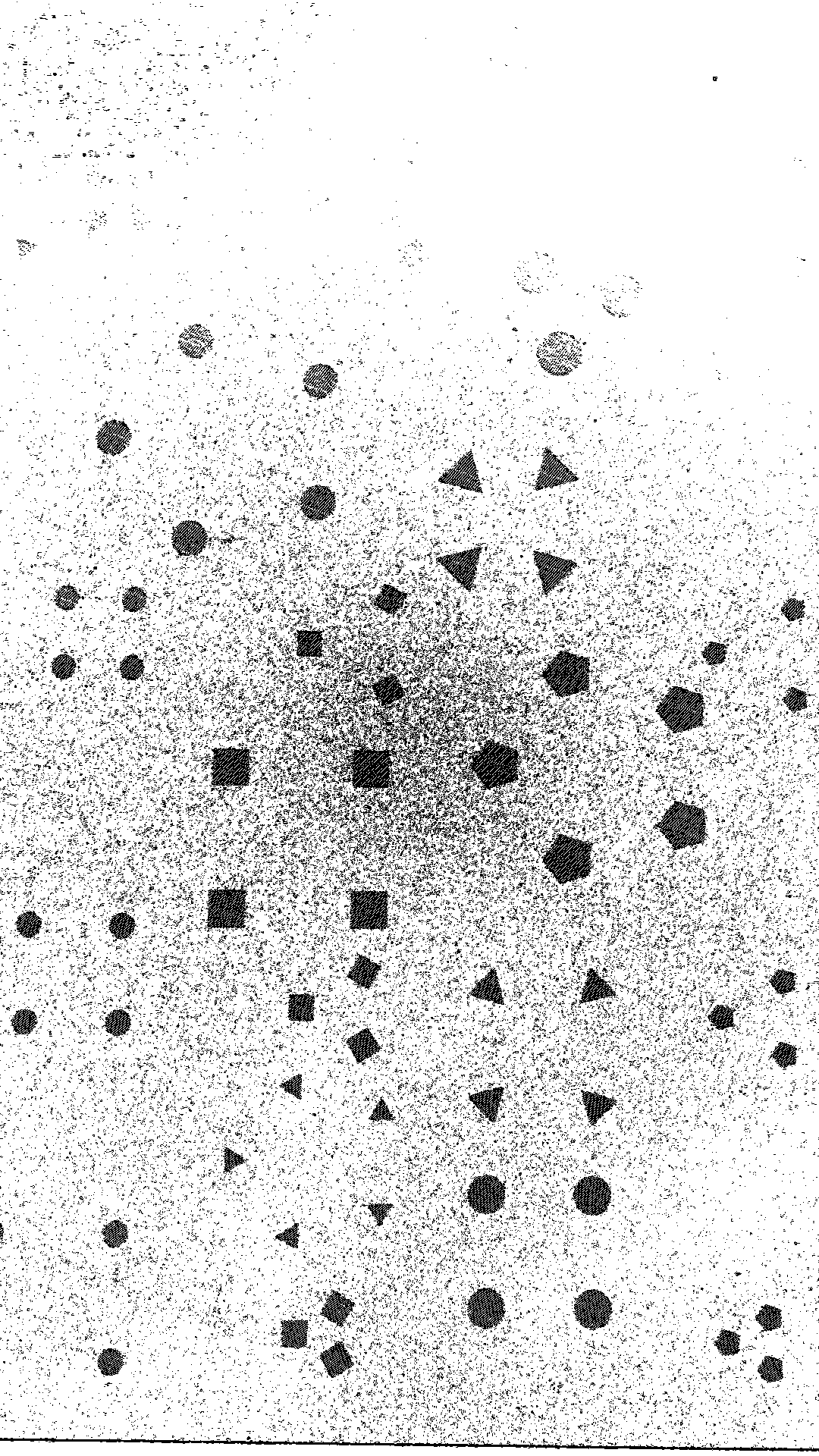
- CoreML Detection Result
Labels on each Shape
| Type | Size | Score |
|---|---|---|
| T: Triangle R: Rectangle P: Pentagon C: Circle |
Number of Pixels Occupied | Confidence Score: 0.0 ~ 1.0 |
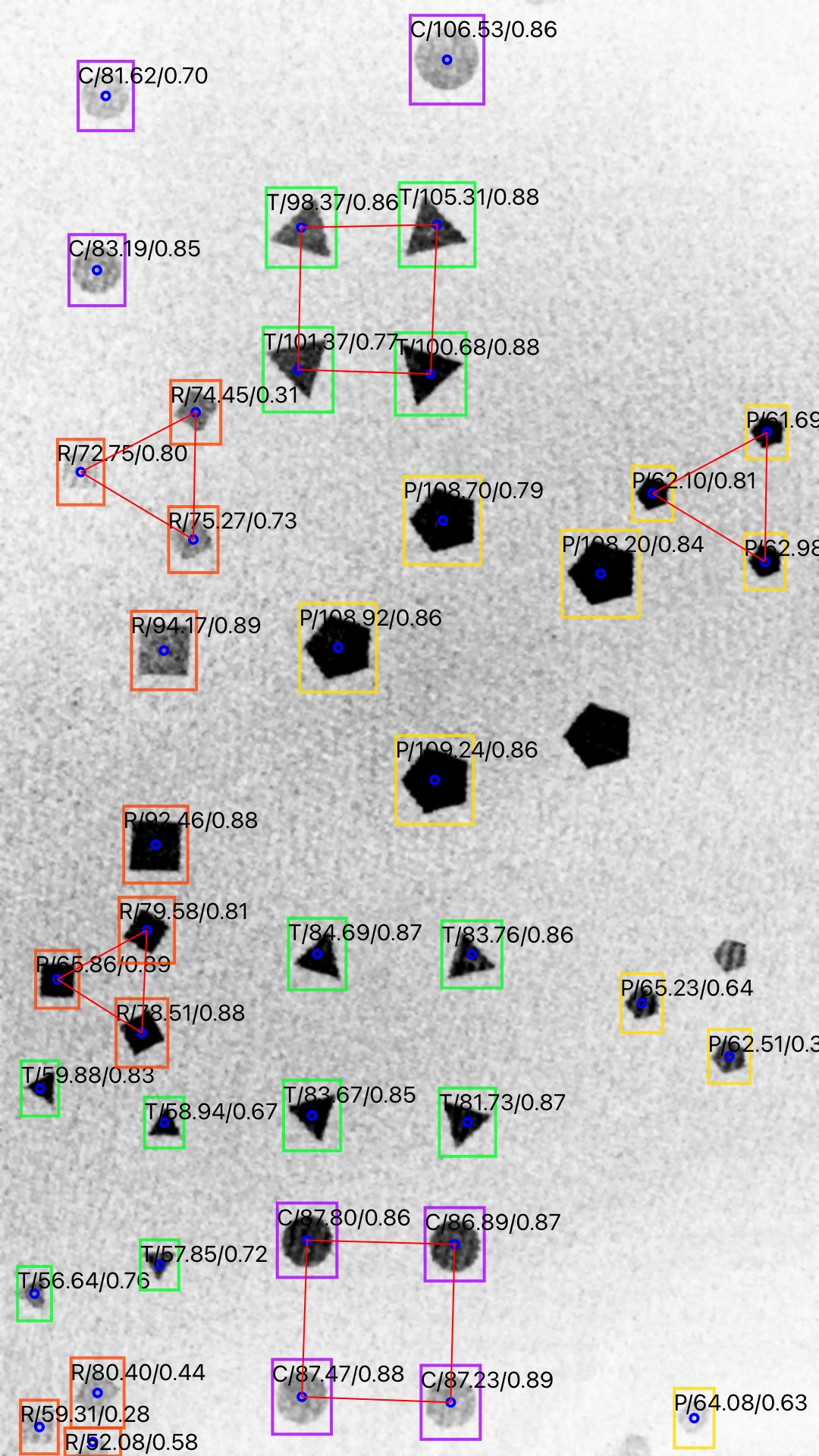
CoreML / Vision Framework
- Add CoreML model file to project
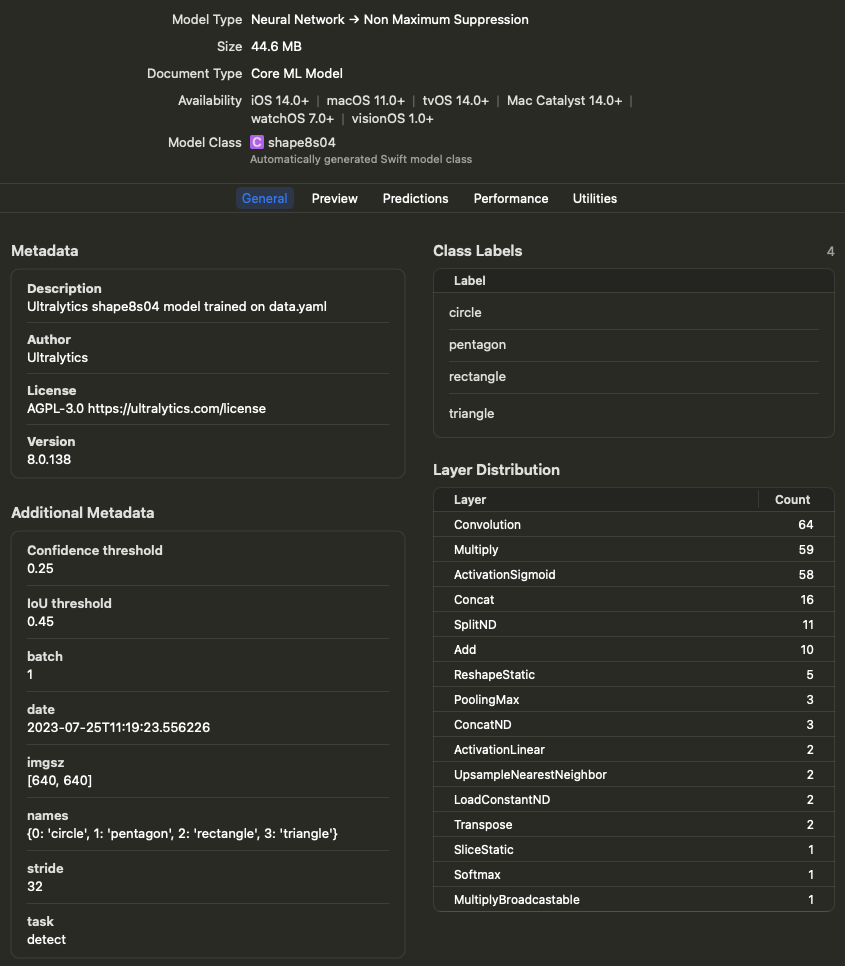
- Setup CoreML
func setUpModel() {
guard let objectDectectionModel = objectDectectionModel else { fatalError("fail to load the model") }
if let visionModel = try? VNCoreMLModel(for: objectDectectionModel.model) {
self.visionModel = visionModel
request = VNCoreMLRequest(model: visionModel, completionHandler: visionRequestDidComplete)
request?.imageCropAndScaleOption = .scaleFill
} else {
fatalError("fail to create vision model")
}
}
- Post-Processing
func visionRequestDidComplete(request: VNRequest, error: Error?) {
if let predictions = request.results as? [VNRecognizedObjectObservation] {
self.predictions = predictions
DispatchQueue.main.async {
if let imageSrc = self.imageAfterOpenCV {
let processor = ShapeProcessor(predictions: self.predictions, imageSrc: imageSrc)
self.openCVIV.image = processor.imageOut
var detectedCode = processor.resultCode
if detectedCode != "NONE" {
if detectedCode == "S3_M4" || detectedCode == "S4_MC" || detectedCode == "S4_M5" || detectedCode == "S4_M3" || detectedCode == "S3_MC" || detectedCode == "S3_M5" || detectedCode == "S3_M3" || detectedCode == "S4_M4" { // 8
self.workDispatch?.cancel()
let resultVC = self.storyboard?.instantiateViewController(withIdentifier: "ResultVC") as! ResultVC
resultVC.resultCode = detectedCode
resultVC.modalPresentationStyle = .fullScreen
self.present(resultVC, animated: false, completion: nil)
self.initTimeout()
}
}
//
if (self.saveImageFlag) {
if let imgOut = processor.imageOut {
UIImageWriteToSavedPhotosAlbum(imgOut, nil, nil, nil)
let saveOkayVC : SaveConfirmVC = self.storyboard?.instantiateViewController(withIdentifier: "saveComplete") as! SaveConfirmVC
self.navigationController?.modalPresentationStyle = UIModalPresentationStyle.currentContext
self.present(saveOkayVC, animated: false, completion: nil)
}
}
self.saveImageFlag = false;
}
self.isInferencing = false
}
} else {
self.isInferencing = false
}
self.semaphore.signal()
}
GPUImage / OpenCV Image Operation
Hidden shapes are invisible with human eyes, and those will be converted with the filters below to be visible.
Filters Applied
if (configType == 7) {
camera = try Camera(sessionPreset: .hd1920x1080)
prewittEdge[0].edgeStrength = 0.7
closing[0].radius = 1
gaussianBlur[0].blurRadiusInPixels = 1
erosion[0].radius = 1
camera --> prewittEdge[0] --> closing[0] --> colorInversion[0] --> gaussianBlur[0] --> erosion[0] --> openCVBuf
camera --> renderView
desiredZoomFactor = 1.6
}
GPUImage Custom Filter for interoperability with CoreML/OpenCV
import CoreGraphics
#if canImport(UIKit)
import UIKit
#else
import Cocoa
#endif
import AVFoundation
import Vision
public class OpenCVBuffer: ImageProcessingOperation {
public var bufferSize:UInt = 1
public var activatePassthroughOnNextFrame = true
public let maximumInputs:UInt = 1
public let targets = TargetContainer()
public let sources = SourceContainer()
var bufferedFramebuffers = [Framebuffer]()
var imageFramebuffer:Framebuffer!
var hasProcessedImage:Bool = false
public var imageAvailableCallback:((UIImage) -> UIImage)?
public init() {
}
public func newFramebufferAvailable(_ framebuffer:Framebuffer, fromSourceIndex:UInt) {
if let imageCallback = imageAvailableCallback {
let cgImageFromBytes = cgImageFromFramebuffer(framebuffer)
let image = UIImage(cgImage:cgImageFromBytes, scale:1.0, orientation:.up)
let transmitImage = imageCallback(image)
let ciImage = CIImage(image: transmitImage)
if let ciImageSafe = ciImage {
let ciContext = CIContext(options: nil)
let cgImage = ciContext.createCGImage(ciImageSafe, from: ciImageSafe.extent)
if let cgImageSafe = cgImage {
//prepareTransmitFrame(image: cgImageSafe)
}
}
}
}
public func prepareTransmitFrame(image:CGImage, smoothlyScaleOutput:Bool = false, orientation:ImageOrientation = .portrait) {
let widthOfImage = GLint(image.width)
let heightOfImage = GLint(image.height)
guard((widthOfImage > 0) && (heightOfImage > 0)) else { fatalError("Tried to pass in a zero-sized image") }
var widthToUseForTexture = widthOfImage
var heightToUseForTexture = heightOfImage
var shouldRedrawUsingCoreGraphics = false
let scaledImageSizeToFitOnGPU = GLSize(sharedImageProcessingContext.sizeThatFitsWithinATextureForSize(Size(width:Float(widthOfImage), height:Float(heightOfImage))))
if ((scaledImageSizeToFitOnGPU.width != widthOfImage) && (scaledImageSizeToFitOnGPU.height != heightOfImage)) {
widthToUseForTexture = scaledImageSizeToFitOnGPU.width
heightToUseForTexture = scaledImageSizeToFitOnGPU.height
shouldRedrawUsingCoreGraphics = true
}
if (smoothlyScaleOutput) {
let powerClosestToWidth = ceil(log2(Float(widthToUseForTexture)))
let powerClosestToHeight = ceil(log2(Float(heightToUseForTexture)))
widthToUseForTexture = GLint(round(pow(2.0, powerClosestToWidth)))
heightToUseForTexture = GLint(round(pow(2.0, powerClosestToHeight)))
shouldRedrawUsingCoreGraphics = true
}
var imageData:UnsafeMutablePointer<GLubyte>!
var dataFromImageDataProvider:CFData!
var format = GL_BGRA
if (!shouldRedrawUsingCoreGraphics) {
if ((image.bytesPerRow != image.width * 4) || (image.bitsPerPixel != 32) || (image.bitsPerComponent != 8))
{
shouldRedrawUsingCoreGraphics = true
} else {
let bitmapInfo = image.bitmapInfo
if (bitmapInfo.contains(.floatComponents)) {
shouldRedrawUsingCoreGraphics = true
} else {
let alphaInfo = CGImageAlphaInfo(rawValue:bitmapInfo.rawValue & CGBitmapInfo.alphaInfoMask.rawValue)
if (bitmapInfo.contains(.byteOrder32Little)) {
if ((alphaInfo != CGImageAlphaInfo.premultipliedFirst) && (alphaInfo != CGImageAlphaInfo.first) && (alphaInfo != CGImageAlphaInfo.noneSkipFirst)) {
shouldRedrawUsingCoreGraphics = true
}
} else if ((bitmapInfo.contains(CGBitmapInfo())) || (bitmapInfo.contains(.byteOrder32Big))) {
if ((alphaInfo != CGImageAlphaInfo.premultipliedLast) && (alphaInfo != CGImageAlphaInfo.last) && (alphaInfo != CGImageAlphaInfo.noneSkipLast)) {
shouldRedrawUsingCoreGraphics = true
} else {
format = GL_RGBA
}
}
}
}
}
if (shouldRedrawUsingCoreGraphics) {
imageData = UnsafeMutablePointer<GLubyte>.allocate(capacity:Int(widthToUseForTexture * heightToUseForTexture) * 4)
let genericRGBColorspace = CGColorSpaceCreateDeviceRGB()
let imageContext = CGContext(data:imageData, width:Int(widthToUseForTexture), height:Int(heightToUseForTexture), bitsPerComponent:8, bytesPerRow:Int(widthToUseForTexture) * 4, space:genericRGBColorspace, bitmapInfo:CGImageAlphaInfo.premultipliedFirst.rawValue | CGBitmapInfo.byteOrder32Little.rawValue)
imageContext?.draw(image, in:CGRect(x:0.0, y:0.0, width:CGFloat(widthToUseForTexture), height:CGFloat(heightToUseForTexture)))
} else {
dataFromImageDataProvider = image.dataProvider?.data
#if os(iOS)
imageData = UnsafeMutablePointer<GLubyte>(mutating:CFDataGetBytePtr(dataFromImageDataProvider))
#else
imageData = UnsafeMutablePointer<GLubyte>(mutating:CFDataGetBytePtr(dataFromImageDataProvider)!)
#endif
}
sharedImageProcessingContext.runOperationSynchronously{
do {
self.imageFramebuffer = try Framebuffer(context:sharedImageProcessingContext, orientation:orientation, size:GLSize(width:widthToUseForTexture, height:heightToUseForTexture), textureOnly:true)
} catch {
fatalError("ERROR: Unable to initialize framebuffer of size (\(widthToUseForTexture), \(heightToUseForTexture)) with error: \(error)")
}
glBindTexture(GLenum(GL_TEXTURE_2D), self.imageFramebuffer.texture)
if (smoothlyScaleOutput) {
glTexParameteri(GLenum(GL_TEXTURE_2D), GLenum(GL_TEXTURE_MIN_FILTER), GL_LINEAR_MIPMAP_LINEAR)
}
glTexImage2D(GLenum(GL_TEXTURE_2D), 0, GL_RGBA, widthToUseForTexture, heightToUseForTexture, 0, GLenum(format), GLenum(GL_UNSIGNED_BYTE), imageData)
if (smoothlyScaleOutput) {
glGenerateMipmap(GLenum(GL_TEXTURE_2D))
}
glBindTexture(GLenum(GL_TEXTURE_2D), 0)
}
if (shouldRedrawUsingCoreGraphics) {
imageData.deallocate()
}
}
public func transmitPreviousImage(to target:ImageConsumer, atIndex:UInt) {
}
func cgImageFromFramebuffer(_ framebuffer:Framebuffer) -> CGImage {
let renderFramebuffer = sharedImageProcessingContext.framebufferCache.requestFramebufferWithProperties(orientation:framebuffer.orientation, size:framebuffer.size)
renderFramebuffer.lock()
renderFramebuffer.activateFramebufferForRendering()
clearFramebufferWithColor(Color.red)
renderQuadWithShader(sharedImageProcessingContext.passthroughShader, uniformSettings:ShaderUniformSettings(), vertexBufferObject:sharedImageProcessingContext.standardImageVBO, inputTextures:[framebuffer.texturePropertiesForOutputRotation(.noRotation)])
framebuffer.unlock()
let imageByteSize = Int(framebuffer.size.width * framebuffer.size.height * 4)
let data = UnsafeMutablePointer<UInt8>.allocate(capacity: imageByteSize)
glReadPixels(0, 0, framebuffer.size.width, framebuffer.size.height, GLenum(GL_RGBA), GLenum(GL_UNSIGNED_BYTE), data)
renderFramebuffer.unlock()
guard let dataProvider = CGDataProvider(dataInfo:nil, data:data, size:imageByteSize, releaseData: dataProviderReleaseCallback) else {fatalError("Could not allocate a CGDataProvider")}
let defaultRGBColorSpace = CGColorSpaceCreateDeviceRGB()
return CGImage(
width: Int(framebuffer.size.width),
height: Int(framebuffer.size.height),
bitsPerComponent: 8,
bitsPerPixel: 32,
bytesPerRow: 4 * Int(framebuffer.size.width),
space: defaultRGBColorSpace,
bitmapInfo: CGBitmapInfo(rawValue: CGImageAlphaInfo.noneSkipLast.rawValue),
provider: dataProvider,
decode:nil, shouldInterpolate:false, intent:.defaultIntent)!
}
}
GPUImage Custom Filter Callback Method
openCVBuf.imageAvailableCallback = {image in
self.imageAfterOpenCV = image
DispatchQueue.main.async{
guard let request = self.request else { fatalError() }
self.semaphore.wait()
let handler = VNImageRequestHandler(cvPixelBuffer: image.pixelBufferFromImage())
try? handler.perform([request])
}
return self.imageAfterOpenCV!
}
Android App - Kotlin / Tensroflow Lite / GPUImage
The Android App is developed using the Kotlin language. The GPUImage available on Android is implemented based on OpenGL ES 2.0, which differs in implementation from iOS’s GPUImage. Consequently, custom filters cannot be used. Instead, the Camera Source was modified to invoke GPUImage Filters upon frame creation, and the resulting output is passed to the ObjectorDetector to perform Shape Detection.
ObjectorDetector Initialization
Initialize the ObjectorDetector to use the Float16-Quantized TFLite file.
if (mlCodeDetector == null) {
// Step 2: Initialize the detector object
val options = ObjectDetector.ObjectDetectorOptions.builder()
.setMaxResults(-1)
.setScoreThreshold(MLDetectActivity.detectThreshold)
.build()
mlCodeDetector = ObjectDetector.createFromFileAndOptions(
mContext,
"float16_metadata_maxout_100.tflite",
options
)
}
Initialize the GPUImage filter settings, apply the filter to the image, and return the result.
private fun GetDCOPBitmap_GPUImg(
lfrmCamPreview: Frame,
lbcdCallback: MLDetectTrackerCallback?
): Bitmap? {
val bmpImageOrg = getBitmapFromRGBFrame(lfrmCamPreview)
if (_GPUIMG == null) {
_GPUIMG = GPUImage(mContext)
var filterGroup = GPUImageFilterGroup()
var grayscaleFilter = GPUImageGrayscaleFilter()
filterGroup.addFilter(grayscaleFilter)
val sharpen = GPUImageSharpenFilter()
sharpen.setSharpness(1.0f)
filterGroup.addFilter(sharpen)
val sobelEdge = GPUImageSobelEdgeDetectionFilter()
//sobelEdge.setLineSize(1.0f)
filterGroup.addFilter(sobelEdge)
var colorInv = GPUImageColorInvertFilter()
filterGroup.addFilter(colorInv)
var boxBlur = GPUImageBoxBlurFilter()
boxBlur.setBlurSize(1.0f)
//filterGroup.addFilter(boxBlur)
val gamma = GPUImageGammaFilter()
gamma.setGamma(0.4f)
//filterGroup.addFilter(gamma)
_GPUIMG!!.setFilter(filterGroup)
}
_GPUIMG!!.setImage(bmpImageOrg)
val filteredBitmap = _GPUIMG!!.bitmapWithFilterApplied
return filteredBitmap
}
Receive the image processed by the GPUImage filter, convert it to a TensorImage, and perform Object Detection.
fun DetectCodes(bmpImage: Bitmap, bcdCallback: MLDetectTrackerCallback?): Bitmap? {
// Step 1: Create TFLite's TensorImage object
val image = TensorImage.fromBitmap(bmpImage)
if (mlCodeDetector == null) {
// Step 2: Initialize the detector object
val options = ObjectDetector.ObjectDetectorOptions.builder()
.setMaxResults(-1)
.setScoreThreshold(MLDetectActivity.detectThreshold)
.build()
mlCodeDetector = ObjectDetector.createFromFileAndOptions(
mContext,
"float16_metadata_maxout_100.tflite",
options
)
}
// Step 3: Feed given image to the detector
val results = mlCodeDetector?.detect(image)
val shapeProc = ShapeProcessor(results, bmpImage)
val imgWithResult = shapeProc.imageOut
if (!shapeProc.resultCode.equals("none", true)) {
val bcdData = Barcode()
bcdData.displayValue = shapeProc.resultCode
bcdCallback?.onDetectedQrCode(bcdData)
}
return imgWithResult
}
Shape Detection Result
